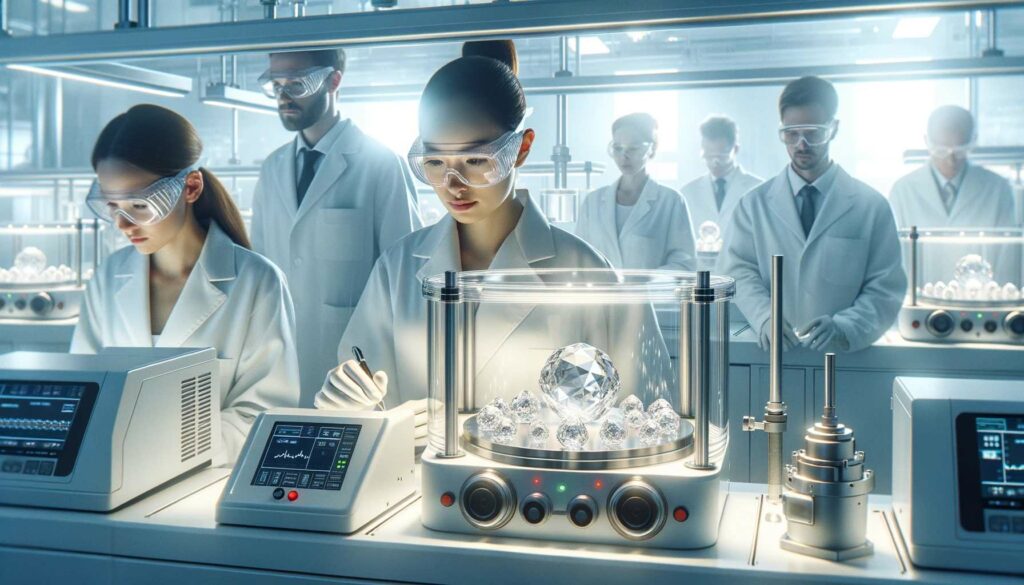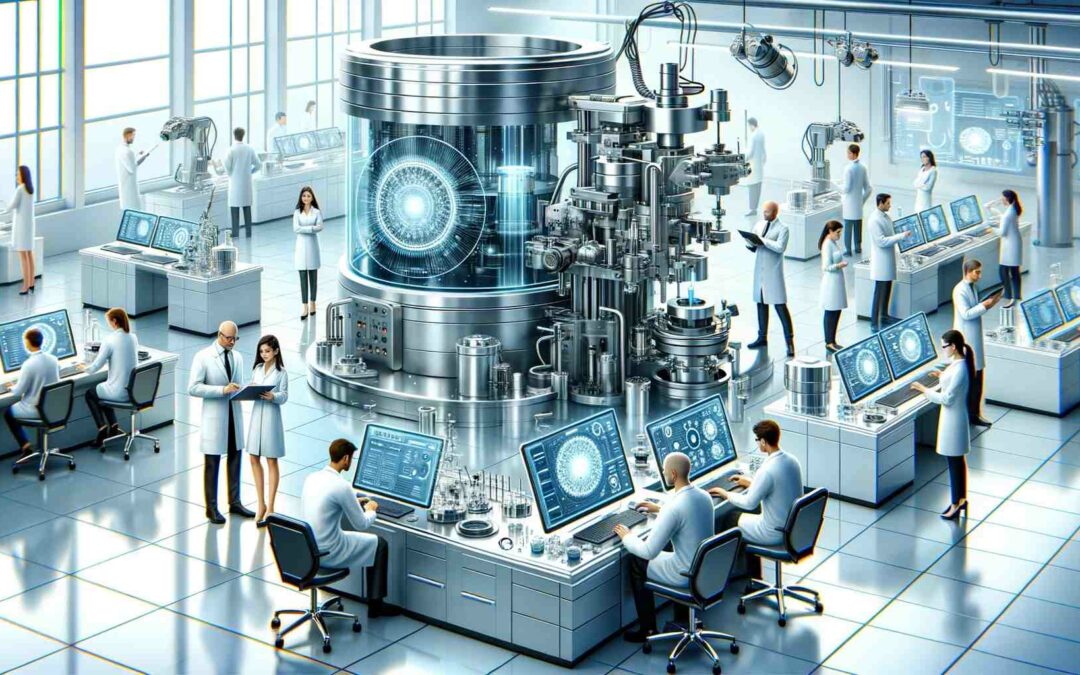Article Contents
- 1 Key Takeaways About Manufacturing Lab-Grown Diamond Jewellery
- 2 Raw Material Selection
- 3 Diamond Growth Process
- 4 Cutting and Shaping Techniques
- 5 Setting and Mounting
- 6 Quality Control and Certification
- 7 Frequently Asked Questions About How Is Lab-grown Diamond Jewellery Manufactured
- 7.1 How Do Lab-Grown Diamonds Compare to Natural Diamonds in Terms of Their Physical and Chemical Properties?
- 7.2 What Are the Environmental Benefits of Choosing Lab-Grown Diamonds Over Natural Diamonds?
- 7.3 Can Lab-Grown Diamonds Be Distinguished From Natural Diamonds by a Regular Consumer?
- 7.4 Are Lab-Grown Diamonds More Affordable Compared to Natural Diamonds, and if So, What Factors Contribute to the Price Difference?
- 7.5 Are There Any Ethical Concerns Associated With the Manufacturing Process of Lab-Grown Diamonds, Such as Labour Conditions or Human Rights Violations?
- 8 Why Choose Lab-Grown Diamonds for Center Stones in Jewelry Manufacturing?
- 9 References Used In This Article
In the world of jewellery, diamonds have always been considered the epitome of elegance and luxury. But have you ever wondered about the process behind the creation of lab-grown diamonds?
This article dives into the technicalities, providing a detailed understanding of how these diamonds are manufactured. From the careful selection of raw materials to the precise cutting and shaping techniques, every step is meticulously executed.
Join us on this journey and answer the question, ‘How is lab-grown diamond jewellery manufactured?’.
Key Takeaways About Manufacturing Lab-Grown Diamond Jewellery
- The selection of carbon sources for lab-grown diamonds affects their quality and characteristics, with carbon sources derived from industrial emissions being a more sustainable option.
- Lab-grown diamonds undergo a controlled growth process in a high-pressure, high-temperature environment, replicating natural diamond formation.
- Advanced laser cutting technology and skilled craftsmanship are used for cutting, shaping, and mounting lab-grown diamonds.
- Lab-grown diamonds undergo quality control measures and certification to ensure authenticity, quality, and compliance with ethical practices.
Raw Material Selection
During the manufacturing process of lab-grown diamonds, raw material selection begins with careful consideration of suitable carbon sources. Diamond synthesis relies on the use of high-quality carbon, which can be sourced from a variety of different materials. The most common carbon sources used in the production of lab-grown diamonds include methane, which is obtained from natural gas, and carbon dioxide, which can be sourced from industrial emissions or captured from the atmosphere. The selection of carbon sources is an essential step in the process, as it directly impacts the quality and characteristics of the lab-grown diamonds produced.
In addition to considering the suitability of carbon sources for diamond synthesis, the environmental impact is also taken into account during raw material selection. Lab-grown diamonds are often considered a more environmentally friendly alternative to mined diamonds, as they require fewer natural resources and have a smaller carbon footprint. By choosing carbon sources that are derived from industrial emissions or captured from the atmosphere, lab-grown diamond manufacturers can reduce their reliance on traditional mining practices and contribute to a more sustainable diamond industry.
Diamond Growth Process
Lab-grown diamonds undergo a carefully controlled growth process, utilizing advanced technology to replicate the natural diamond formation. This process involves creating the ideal conditions for crystal formation and growth. To initiate the growth, a small diamond seed is placed in a high-pressure, high-temperature (HPHT) environment. The HPHT method uses a press to subject the diamond seed to extreme pressure and temperature, mimicking the conditions found deep within the Earth where natural diamonds form. The growth conditions are carefully monitored and controlled to ensure the formation of high-quality diamonds.
During the growth process, carbon atoms are introduced to the diamond seed, allowing the crystal lattice to expand. These carbon atoms attach themselves to the existing lattice, causing the diamond to grow layer by layer. The growth rate can vary depending on the desired size and quality of the diamond, with larger diamonds typically requiring longer growth times.
The growth conditions play a crucial role in determining the characteristics of the lab-grown diamond. Factors such as temperature, pressure, and the type and concentration of carbon sources can influence the diamond’s color, clarity, and size. By carefully controlling these parameters, manufacturers can produce diamonds with specific qualities to meet the diverse demands of consumers.
Cutting and Shaping Techniques
After undergoing the growth process, lab-grown diamonds are subjected to cutting and shaping techniques to enhance their brilliance and beauty. To achieve the desired shape and proportions, the diamonds are carefully cut using advanced laser cutting technology. Laser cutting offers precise control and allows for intricate designs to be achieved with utmost accuracy.
Precision shaping is another crucial step in the manufacturing process of lab-grown diamonds. This process involves carefully shaping the rough diamond into its final form, whether it be a round brilliant cut, princess cut, or any other popular diamond shape. Skilled craftsmen use specialized tools and techniques to ensure that each facet is cut at the correct angle and dimension, maximizing the diamond’s ability to reflect and refract light.
During the cutting and shaping process, the diamond is carefully examined at every stage to ensure that the desired proportions and symmetry are achieved. This meticulous attention to detail is necessary to create diamonds that exhibit exceptional brilliance, fire, and scintillation.
Setting and Mounting
The craftsman carefully examines the diamond’s proportions and symmetry during the setting and mounting process. This step is crucial in ensuring that the diamond is securely and beautifully positioned in its setting.
Here are the different types of diamond settings and the importance of precision in diamond mounting:
- Prong Setting: This classic setting involves using small metal claws or prongs to hold the diamond in place. The number of prongs can vary, with four or six-prong settings being popular choices. The craftsman meticulously positions each prong to ensure a secure grip on the diamond.
- Bezel Setting: In this setting, the diamond is completely surrounded by a metal rim. The craftsman carefully shapes the metal to perfectly fit the diamond, creating a smooth and secure setting.
- Channel Setting: This setting involves placing multiple diamonds into a channel made in the metal. The craftsman must precisely position each diamond to ensure a uniform and seamless appearance.
Precision is of utmost importance in diamond mounting. Any slight deviation in positioning or symmetry can affect the overall look and security of the diamond. The craftsman must work meticulously to ensure that the diamond is securely held in place and that its brilliance is maximized.
The result is a beautifully set diamond that sparkles with freedom and elegance.
Quality Control and Certification
Quality control and certification play a crucial role in ensuring the authenticity and adherence to standards of lab-grown diamonds. To maintain consistency and transparency, lab-grown diamonds are subjected to a rigorous grading process that follows established grading standards.
Grading standards for lab-grown diamonds are similar to those used for natural diamonds, with a few key differences. These standards evaluate the characteristics of the diamond, such as colour, clarity, carat weight, and cut. However, since lab-grown diamonds are created in controlled environments, they often exhibit fewer flaws and inconsistencies compared to natural diamonds. This can result in higher grades for lab-grown diamonds in terms of clarity and colour.
In addition to grading, ethical considerations are also taken into account during quality control and certification processes. Lab-grown diamonds are seen as a more ethical alternative to natural diamonds, as they don’t contribute to environmental destruction or human rights abuses associated with diamond mining. To ensure ethical practices, certification bodies assess the origin of the lab-grown diamonds and verify that they’re produced in compliance with ethical guidelines.

Frequently Asked Questions About How Is Lab-grown Diamond Jewellery Manufactured
How Do Lab-Grown Diamonds Compare to Natural Diamonds in Terms of Their Physical and Chemical Properties?
Lab-grown diamonds, in terms of their physical and chemical properties, can closely resemble natural diamonds. They have the same crystal structure, hardness, and optical properties due to their identical chemical composition of carbon atoms arranged in a lattice structure.
What Are the Environmental Benefits of Choosing Lab-Grown Diamonds Over Natural Diamonds?
Choosing lab-grown diamonds over natural ones offers significant environmental benefits. The manufacturing process of lab-grown diamonds has a lower environmental impact, promoting sustainability. This choice aligns with the audience’s desire for freedom and a greener future.
Can Lab-Grown Diamonds Be Distinguished From Natural Diamonds by a Regular Consumer?
Lab-grown diamonds can be difficult for a regular consumer to distinguish from natural diamonds. Consumer awareness is crucial in understanding the differences between the two, as lab-grown diamonds have identical physical and chemical properties to natural diamonds.
Are Lab-Grown Diamonds More Affordable Compared to Natural Diamonds, and if So, What Factors Contribute to the Price Difference?
Lab-grown diamonds are indeed more affordable compared to natural diamonds due to factors such as lower production costs and market demand. Understanding the manufacturing process helps explain these price differences in detail.
Are There Any Ethical Concerns Associated With the Manufacturing Process of Lab-Grown Diamonds, Such as Labour Conditions or Human Rights Violations?
Labour conditions and potential human rights violations are ethical concerns associated with the manufacturing process of lab-grown diamonds. It is important to ensure that these diamonds are produced in a manner that respects the rights and well-being of workers.
Why Choose Lab-Grown Diamonds for Center Stones in Jewelry Manufacturing?
Lab-grown diamonds offer an ethical, sustainable, and cost-effective alternative for center stones in jewelry. When comparing moissanite vs lab or natural diamonds, lab-grown options shine as they are identical to natural diamonds in brilliance and durability, yet free from mining’s environmental toll, making them a responsible and stunning choice. Moissanite, on the other hand, is a great alternative to natural diamonds as well, but it may not have the same level of durability and brilliance as lab-grown or natural diamonds. Additionally, moissanite does not have the same ethical and sustainable credentials as lab-grown diamonds, as it is not free from the environmental impact of mining. Therefore, when considering ethical, sustainable, and cost-effective options for center stones in jewelry, lab-grown diamonds outshine both natural diamonds and moissanite.
References Used In This Article
- How are lab-grown diamonds made?: https://www.queensmith.co.uk/diamond-guides/lab-grown-diamonds/how-are-lab-grown-diamonds-made
- Lab-Grown Diamond Production Methods: https://www.gemsociety.org/article/lab-grown-diamond-production-methods/
- What are laboratory-grown diamonds?: https://4cs.gia.edu/en-us/laboratory-grown-diamond/
- The sparkling rise of the lab-grown diamond: https://www.bbc.com/future/article/20200207-the-sparkling-rise-of-the-lab-grown-diamond

